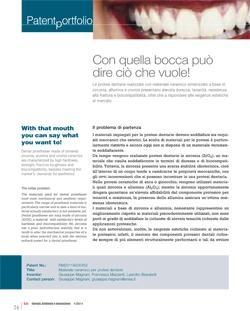
Con quella bocca può dire ciò che vuole!
I materiali impiegati per le protesi dentarie devono soddisfare sia requisiti meccanici che estetici. La scelta di materiali per le protesi è particolarmente ristretta e ancora oggi non si dispone di un materiale veramente soddisfacente. Da tempo vengono realizzate protesi dentarie in zirconia, un materiale che risulta soddisfacente in termini di durezza e di biocompatibilità. Tuttavia, la zirconia presenta una scarsa stabilità idrotermica, cioè all’interno di un corpo tende a cambiarne le proprietà meccaniche, con gli ovvi inconvenienti che si possono incontrare in una protesi dentaria. L’ENEA ha brevettato un materiale ceramico sinterizzato dalle elevate proprietà meccaniche e particolari caratteristiche estetiche a base di zirconia stabilizzata in fase tetragonale, allumina e cromia. Questi materiali ceramici, rispetto a quelli comunemente usati, presentano nel complesso delle caratteristiche meccaniche migliorate. Nello specifico, hanno una tenacità marcatamente superiore e, allo stesso tempo, possono essere sottoposti a un trattamento di post - sinterizzazione, ottimizzando, così, le proprietà relative alla resistenza a flessione e alla durezza, senza per questo comprometterne la tenacità e risultando adatti per la realizzazione di protesi dentarie.
With that mouth you can say what you want to!
The materials used for dental prostheses must meet mechanical and aesthetic requirements. The range of prosthesis materials is particularly narrow and to date a kind of material actually satisfactory is not available yet. Dental prostheses are long made of zirconia, a material with optimum levels of hardness and biocompatibility. Yet, zirconia has a poor hydrothermal stability, that is it tends to alter the mechanical properties of a body when inserted into it, with the obvious setback posed for a dental prosthesis. ENEA has patented sintered tetragonal stabilized zirconia, alumina and cromia ceramics having high mechanical properties and particular aesthetic characteristics. If compared to the ceramics commonly used, the ENEA-patented ones have better mechanical characteristics as a whole. Specifically, such ceramics have considerably higher toughness and, at the same time, can be post-sintered, thus optimizing the flexural strength and hardness properties without compromising their toughness and being suitable for making dental prostheses.

